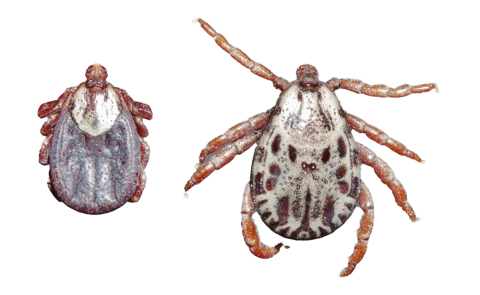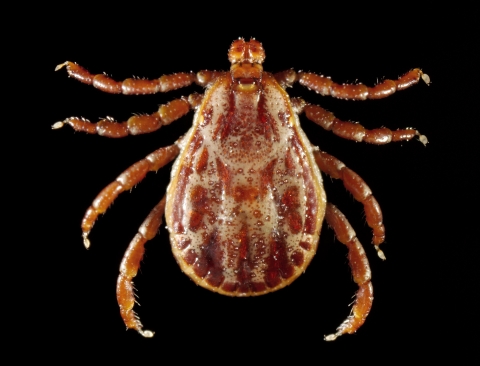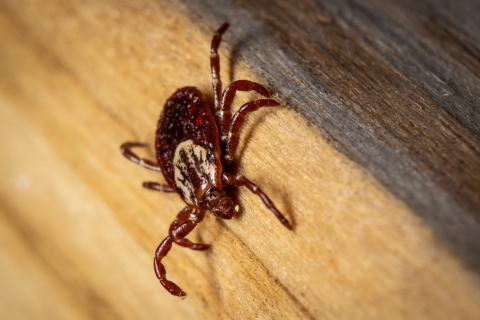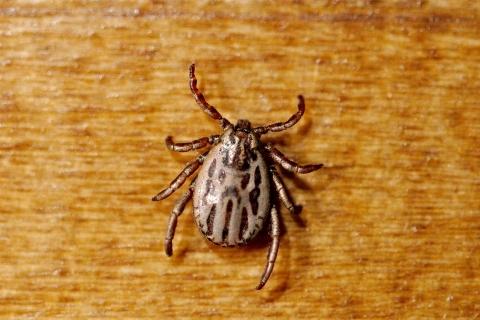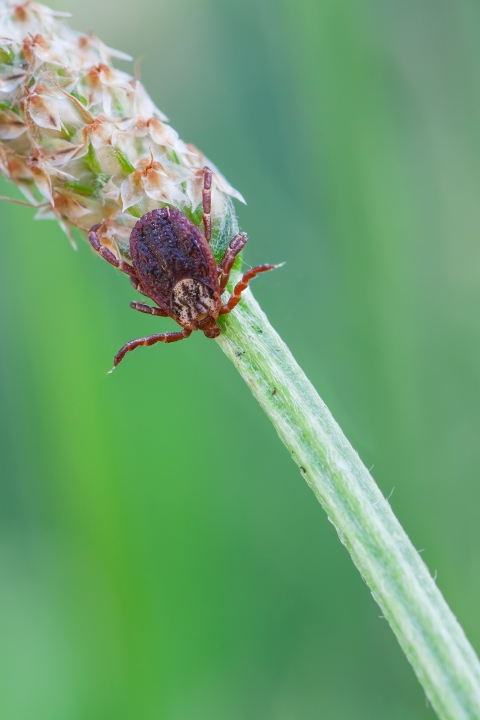Welcome to Tick Country
Visitors to Turnbull NWR regularly visit the refuge to enjoy its scenic auto tour, hike one of its many trails, or for the chance to see some interesting wildlife. The most commonly encountered wildlife, unfortunately, is ticks. Exactly why Turnbull is home to so many ticks is a question biologists are still trying to understand. Regardless, it is almost impossible to visit the refuge during the spring and summer months without finding at least one of these arachnids.
Tick Identification
Turnbull NWR is host (pun intended) to three kinds of tick. Two species are wood ticks, part of the hard tick family and distinguished by their hard shields, or scutums, and prominent heads. Winter ticks, in contrast, are generally smaller and are identified by their reddish-brown color and creamy white dorsal shield.
Ticks are arachnids, and most closely related to spiders, scorpions, and mites. They remain inactive during the winter months (except for Winter Tick), becoming active again with warmer spring weather, which is also when females will lay their eggs. If adult females cannot find a suitable host during the fall, they will turn dormant and survive in leaf litter until the next spring. This is why it is important to conduct tick checks after being outside in the woods, no matter what season it is.
Rocky Mountain Wood Tick (Dermacentor andersoni)
Found throughout the northwest United States and southwest Canada along the Rocky Mountains, the Rocky Mountain Wood Tick is a hard tick most commonly encountered at the refuge. These ticks prefer woodland areas, medium height grasses, shrubs between wetlands and woods, and sunny open areas along the edge of woods. Adult ticks feed primarily on large mammals, while larvae and nymphs feed on small rodents. Adult wood ticks can survive for up to 600 days without feeding. Adult male and female wood ticks can be active from January through November but are most commonly encountered April through July, with their activity diminishes during the hot and dry mid-summer period. Nymphs and larvae are rarely encountered on people or pets but are most likely encountered in June, July, and August.
American Dog Tick (Dermacentor variabilis)
The American Dog Tick is another hard tick, albeit much more uncommon. It is visually almost indistinguishable to the Wood Tick, with microscopic examination generally required to distinguish between the two. This species is predominantly found east of the Rocky Mountains, but can be found in locations across eastern Washington, including Turnbull. These ticks like humid, outdoor environments and tend to be found on tall grass or low brush, along the edges of trails, pastures, and wooded areas with deeper litter for early life stages. American dog ticks are 3-host ticks, meaning they use 3 different hosts in their lifecycle. They are common pests of dogs, but will feed on a variety of animals ranging in size from rodents to livestock. Adult stages prefer medium-sized hosts, including racoons, skunks, cats, dogs and other canids. Larvae and nymphs mainly infest small mammals including mice, voles, rats, and chipmunks. Adult males and females are active April-early August in most regions. Adult dog ticks commonly attack humans, but nymphs and larvae rarely attach to people or pets.
Winter Tick (Dermacentor albipictus)
The winter tick is a one-host tick, with all three active life stages (larvae, nymphs, and adults) feeding on the same individual. They produce one generation per year, with larvae hatching and questing from late summer through fall. Large numbers of these tiny larvae are commonly encountered by hunters in the fall. The ticks will feed and remain on their host during their subsequent molts until spring when adult females detach and drop to the ground. Eggs are laid in June, after which the adult females die. Winter ticks are most commonly encountered in fall and winter. Their preferred hosts are moose and other ungulates, including deer, elk, and caribou, and occasionally horses and cattle. Though they can be found anywhere on a host, they seem to prefer the ears, belly, anal region, and under the legs. Incidental hosts include dogs, beavers, black bears, and coyotes. Winter ticks rarely bite and feed on humans.
Tick-Borne Diseases
All ticks can and do carry diseases that can be transmitted to humans, pets, or wildlife. Nymphs and adults of both wood ticks and dog ticks can transmit Rocky Mountain Spotted Fever (RMSF) and Colorado tick fever virus (CTFV) to humans, cats, and dogs. They also transmit the germ causing Tularemia, also known as "rabbit fever." Rocky Mountain wood tick saliva contains a neurotoxin that can occasionally cause tick paralysis in humans and pets; usually a bite from an adult female induces an ascending paralysis that dissipates within 24-72 hours after tick removal.
The ticks located at Turnbull National Wildlife Refuge DO NOT carry Lyme disease.12 Lyme is caused by the bacterium Borrelia burgdorferi and transmitted by deer (blacklegged) ticks, which are not located in Eastern Washington. Most reported cases of Lyme in Spokane County are the result of individuals who have contracted the disease while traveling in the Eastern or Midwest parts of the country.
Symptoms of a tick-borne disease include fever, headaches, joint aches and pains, and a rash. A tick bite is usually a red raised bump like a nasty mosquito bite. If a rash is present, an infection has likely developed, though it’s not possible to tell what kind by the rash alone. The distinctive bull's eye rash many people associate with Lyme disease can be caused by other tick-borne pathogens and it is still possible to contract a disease if the rash looks different or if there’s no rash at all. If fever or malaise also develops, even if a rash is not present, then it is recommended to visit a medial professional for an evaluation.
It takes between 6 to 8 hours of feeding for a tick to transmit any diseases it may be carrying, so the sooner you remove it the better. If you find an engorged tick on your body that’s clearly been there a while, you are at higher risk for a disease.
How to Recreate Responsibly in Tick Country
Summer brings warm weather and great hiking. Unfortunately, ticks appreciate the season as much as people. Humans are at most risk of a tick bite between May and July when larva ticks mature into nymphs.
Tick Prevention Starts by Covering Up
Minimizing exposure to ticks begins with proper clothing. Ticks tend to latch on in grassy areas above the cuff of the pant-leg and move upward, looking for dark places to burrow. Here are a few tips for hikers:
- Wear pants and long sleeves — no shorts! The best choice is convertible pants with a flap over the zippered legs — this is an excellent tick trap.
- Tuck your shirt into your pants. Tuck your pants into your socks.
- Wear light colors, so you can identify the ticks more easily as they climb.
- Don a cap with a flap behind the neck, if you have one.
Bug sprays approved by the Environmental Protection Agency — like those containing DEET, picaridin or oil of lemon eucalyptus — repel ticks, but some formulations work better than others, or only protect skin for one hour, so you may need to reapply regularly. Anecdotal reports from hikers report that DEET works great for mosquitoes, but not so well for ticks. Permethrin is a better choice for ticks; several brands of clothing are made with Permethrin-infused fabric, or you can buy a spray.
Note: These are pesticides. Keep that in mind as you decide how you want to use them. Permethrin is especially toxic to cats.
During and After Your Hike
Stick to the trail.
Ticks like to hang out in shaded, grassy areas. Sticking to an established trail is good prevention, but certainly is not foolproof. This is one more great reason to keep dogs on leash.
Tick check frequently.
Hikers in tick country will want to do regular tick checks during the day. Brush those them off or crush them with a fingernail, but don't worry that they are going to burrow in immediately. Ticks like to crawl around, typically upward, for a while before they take a bite.
Post-hike tick check.
After your hike, do a thorough check. You may even opt to change into a complete set of new clothes back at the trailhead. If you choose this method, put all of clothing in a garbage bag and seal it, then do a full body check. Favorite tick burrowing sites include the scalp, waist, groin, and other dark places where they can hide.
Back home, take a shower.
Consider filling up a bathtub or washbasin and tossing in your hiking clothes. Ticks will float up to the surface. Crush them or flush them down the toilet — note that they can survive a wash and rinse cycle.
Check your backpack.
Don't forget to give your backpack a full check too. Leave it outside rather bringing it in your home.
What To Do If You Have a Tick
1. Find pointy tweezers
First, let’s state the obvious, ticks are tiny. Household tweezers just aren’t the right tool for proper tick removal. Unfed adult ticks are about the size of an apple seed; nymph stage ticks are significantly smaller, about the size of a poppy seed. Ticks change in size and appearance as they engorge. Precision tweezers, such as those used for eyebrows or ingrown hairs are more suited to the task of tick removal. The use of household tweezers increases the chances of squeezing the tick (and any germs residing in the back end) into the host, or tearing the tick during removal, especially tiny nymphs which are active from early April to early August.
2. Disinfect the area
Disinfect the tick-bite area with rubbing alcohol.
3. Grab the head
When finished, place the tweezers as close to the skin as possible. Use of a precision tweezer should allow you to grab the tick’s head or directly above the head.
4. Firmly pull straight out
Once you’ve grabbed the tick firmly between your pointy tweezer, the best method is to apply a slow, steady, upwards pull in order to avoid breaking the tick. You should not be concerned if the tick head breaks off and remains in the skin. Tickborne disease transmission is not possible without the tick’s body.
5. Disinfect again
Once the tick is removed, disinfect the tick-bite area again with rubbing alcohol.
6. Consider testing
Once you have the tick removed, you should consider sending the tick to a lab for testing of tickborne disease.
What to Do If Your Pet Has a Tick
First things first: don't panic. To reiterate from above: it takes between 6 to 8 hours of feeding for a tick to transmit any diseases it may be carrying, so the sooner you remove it the better. Always wear gloves and use a set of tweezers to firmly grasp the tick by the head. Don't pull the tick by the body or its head will dislodge and remain in your dog or cat. Instead, use a steady upwards motion and pull until the tick's head releases. Then, throw the body into a glass jar and call a veterinarian. Describe the tick to your vet and ask if they'd like you to bring it in to be tested for diseases. After removing the tick from your pet, swab the bite with an alcohol swab or other antiseptic and put a dab of topical antibiotic the the skin. Keep an eye on your pet for the next couple of weeks to monitor for symptoms of tick-borne infection.
Additional Resources
Washington State Department of Health
Spokane Regional Health District
National Geographic - How to protect yourself from ticks
NYT - You Really Are a Tick Magnet


